A two-day Private Tour, in the Broads and North Norfolk. We had great weather – frosty overnight, but then bright & sunny days with light winds. Perfect for winter birding.
Day 1
We headed out east, down to the Broads today, driving into a glorious sunrise on our way. When we arrived at Buckenham, there was still a bit of low mist out across the grazing marshes and it didn’t help we were looking into the sun from the track. We couldn’t immediately see the Taiga Bean Geese from here, but we could see lots of Chinese Water Deer.
We continued on to the fishermen’s car park down by the river and took the track out towards the old windpump. There were lots of Wigeon out on the marshes, which flew round in the early sunshine from time to time, whistling, flushed by the local Marsh Harriers. A Common Buzzard perched in the top of one of the trees at the back.
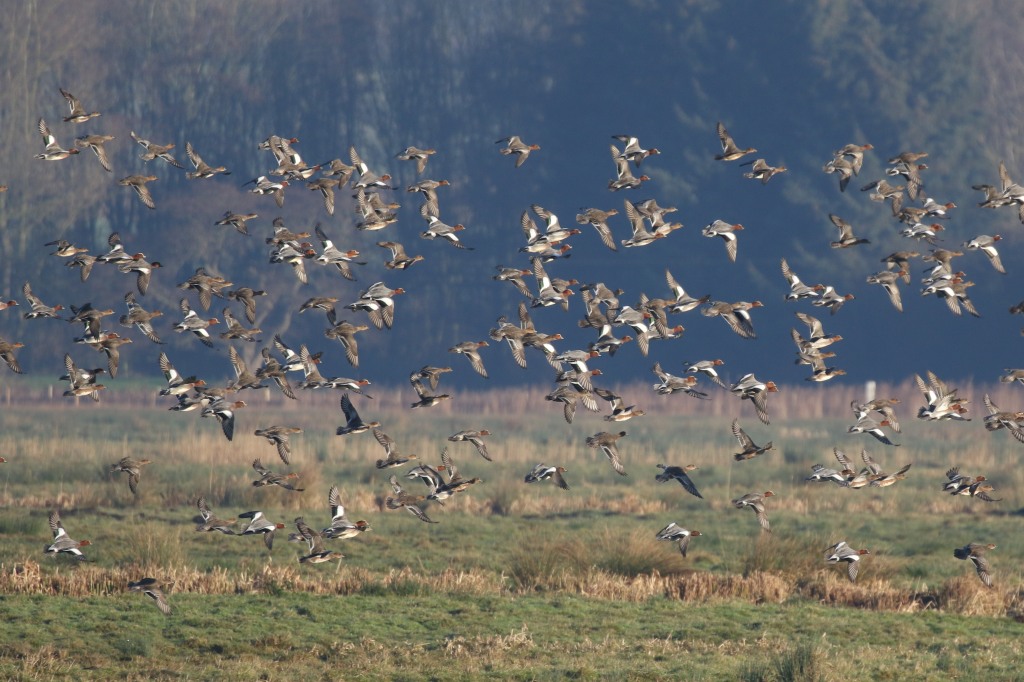
Half way along, we stopped to scan again. This time we quickly found the Taiga Bean Geese, right over on the far side, in their favoured spot. They were asleep, but one did lift its head from time to time.
There were a few other geese here too, a large gaggle of Canada Geese out on the grass closer to us, and several Barnacle Geese with them. A small group of Pink-footed Geese flew in, and started to drop down onto the marshes. Two White-fronted Geese appeared and circled with them, so we could see their white fronts and black belly bars, before they flew off west on their own.
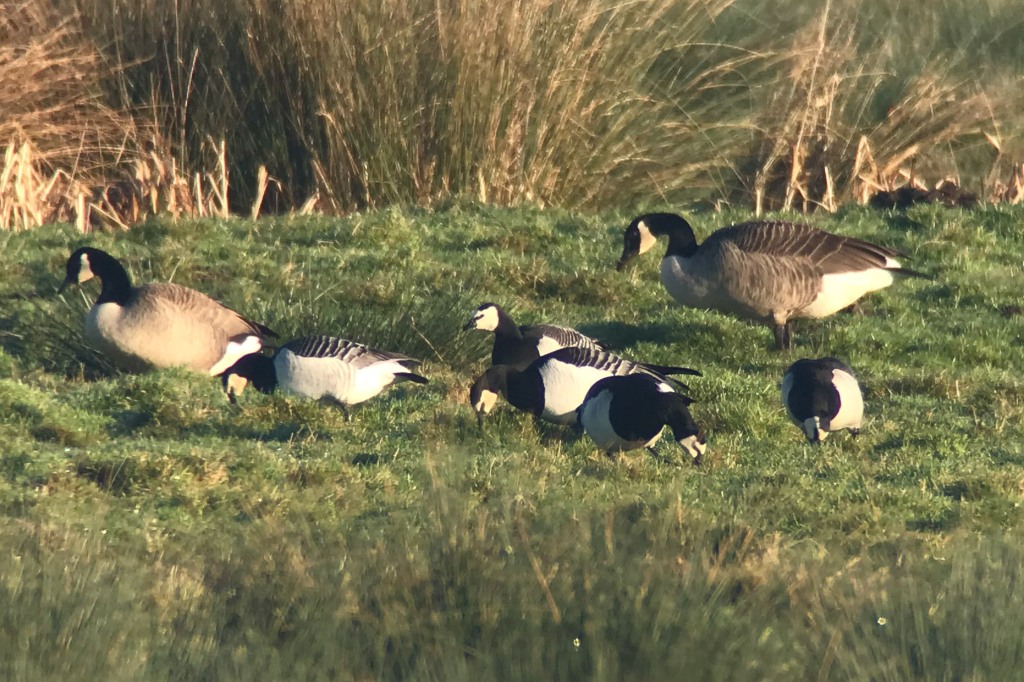
Continuing on, we climbed up onto the top of the riverbank beyond the windpump. The Taiga Bean Geese were awake now but had walked back into the rushes. They were harder to see now, particularly with their heads down feeding, but they lifted their heads up occasionally, and then we could see their extensively orange bills catching the light in the sunshine.
Mission accomplished, we walked back to the car park for a coffee break. There were more ducks on the pools here, lots more Wigeon, plus Teal and Shoveler. Afterwards, as we drove back round to Strumpshaw, we stopped to admire three Mistle Thrushes and several Fieldfares feeding in the paddocks
At Strumpshaw, we stopped to watch the tits coming and going from the feeders. A Marsh Tit called from the trees. Reception pool was still largely frozen and most of the ducks were hidden round behind the reeds. Gadwall and Coot were additions to the trip list. Something flushed them all out, but we couldn’t see what – the ducks whirled round, and several crashed back down into the ice. It looked a painful way to land on the water!
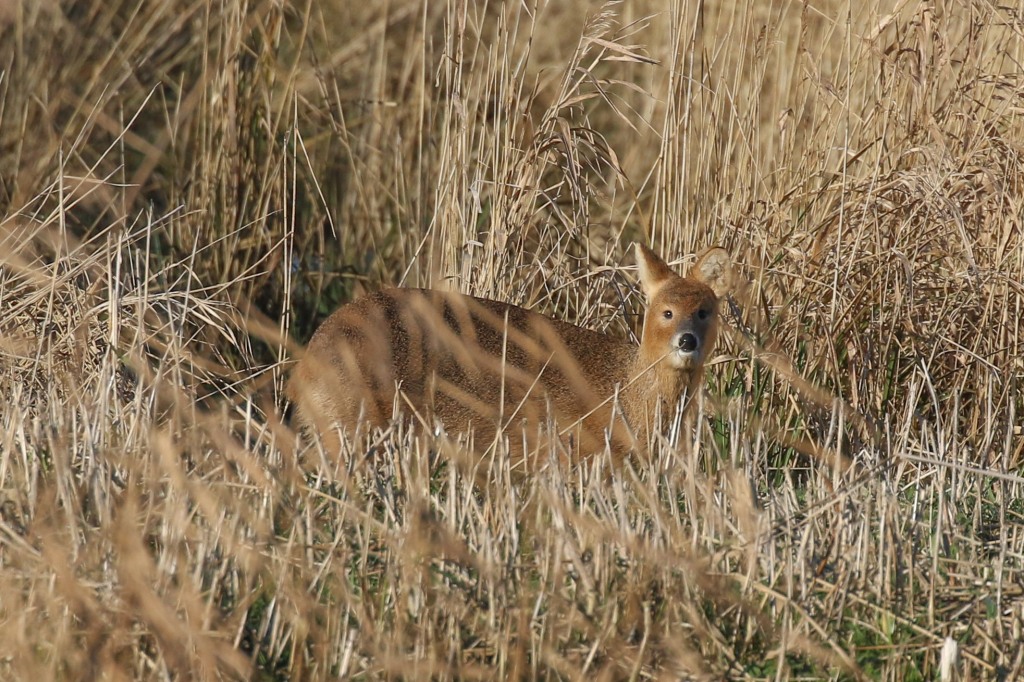
Down through the trees towards Sandy Wall, there were lots of Siskins in the tops of the alders. A Long-tailed Tit was feeding in the trees by the path and a pale Common Buzzard was perched in the sunshine out on the Fen. We had a quick look from Fen Hide, but it was quite icy and rather quiet. A couple of Chinese Water Deer were feeding on the edge of the reeds and we heard Bearded Tits calling.
On our way back to Reception, we stopped to listen to a Robin just above the path which looked stunning in the low sunshine. We stopped for an early lunch at the picnic tables and a couple of Marsh Tits now came in and out from the feeders.

After lunch, we drove round to Ormesby Little Broad and took the path out to the viewing platform. A Cetti’s Warbler sang from the edge of the ditch by the path, and we even had a quick glimpse of it as it flew across. Out at the platform, the Red-necked Grebe was showing well on the Broad. There was a Great Crested Grebe nearby too, and we had a good comparison of the two species side by side at one point. A couple of skeins of Pink-footed Geese came over high calling.
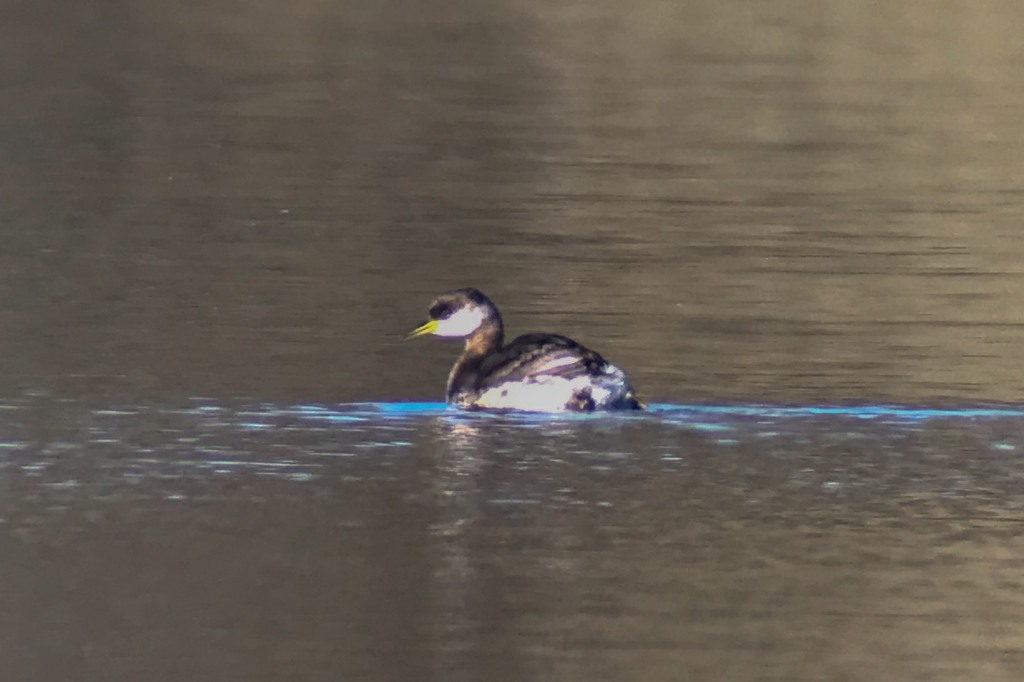
On our way north, we had a quick look for Common Cranes in the fields. They had been reported here earlier, but there was no sign at the first place we tried. Further along, we came round the corner to find two lorries had collided trying to pass each other on the narrow road. No one hurt, they were just leaning into each other, but they seemed to be stuck and it didn’t look like they would be going anywhere soon, so we turned round. We were heading to Stubb Mill later, so would hopefully catch up with Cranes there.
Our next stop was at Ludham Airfield. We quickly located a small herd of swans on the far side, in a field of winter wheat. They were mostly Whooper Swans, we counted 24 of them, but they were accompanied by one family of Bewick’s Swans, a pair with their two juveniles. It was a good opportunity to get a comparison of the two species side by side.
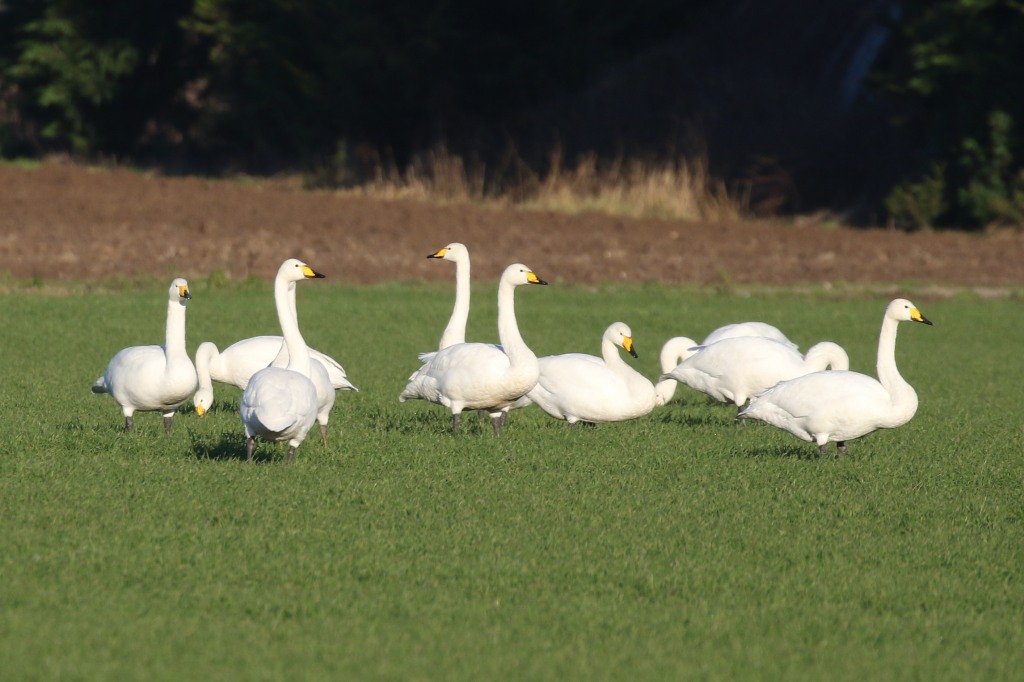
After Ludham, we drove on to Hickling Broad and made our way out to the Stubb Mill watchpoint. As we scanned over the marshes in front, the first bird we saw was a Merlin perched on a bush. They can come in very late and be rather distant here, but this Merlin stayed perched in the sunshine not too far out from the veiwpoint all the time we were there. Very obliging!

A pair of Common Cranes was feeding out on the marshes further back. They were hard to see at first, behind the reeds and brambles, we could either see a bustle or an occasional head up. When they took off and flew across we had a much better view. They landed again out of view in the middle, then flew again, and disappeared off left. We could hear more Cranes calling behind Stubb Mill, out on the reserve.
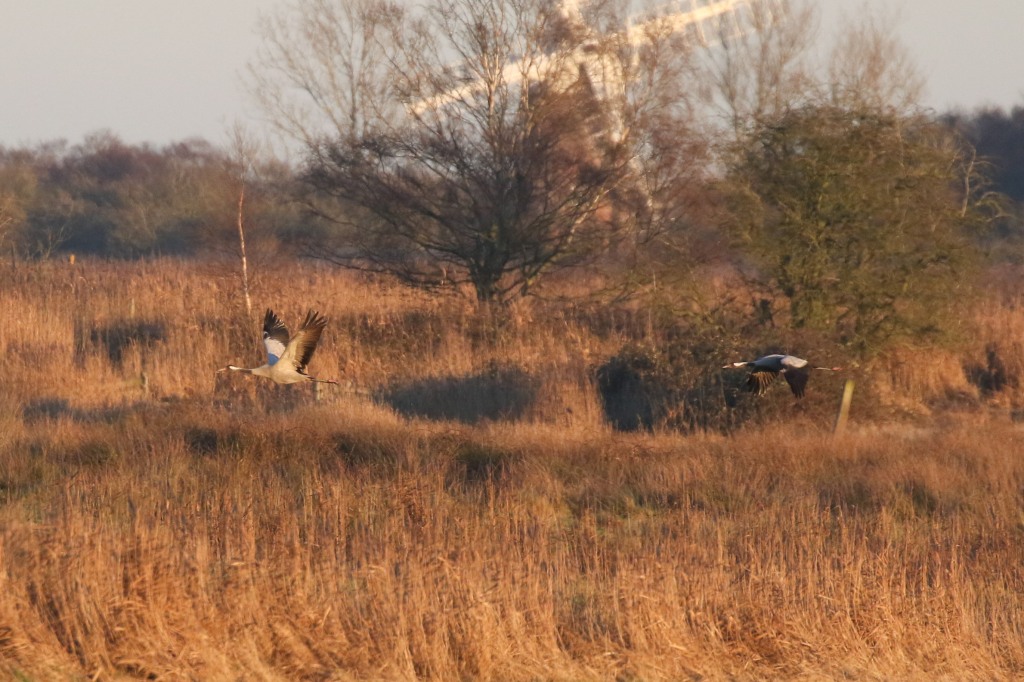
There were a few other birds here too this afternoon. A small flock of Lesser Redpolls flew over and landed in the trees by the mill, before flying back to feed in the trees just behind the watchpoint. A Kingfisher shot across low in front of us, but it disappeared quickly behind the bushes.
A Barn Owl appeared from behind Stubb Mill, hunting out in front of the viewpoint. It wasn’t in view for long, before it turned sharply and plunged into the long grass. It had obviously been successful, as it stayed down for some time. When it eventually flew up again, it disappeared back round behind the mill.

The harriers were rather slow to come in today, making the most of the late afternoon sunshine to hunt late. There were a few Marsh Harriers already in when we arrived, and a trickle drifting in afterwards, but as the sun went down it accelerated. Somebody picked up a ringtail Hen Harrier, over the reeds at the back, but it was hard to see, and disappeared back into the trees. Then a ghostly grey male Hen Harrier appeared out by the old mill, and we watched it for a while as it flew in and out of the trees.
That was our last target for the day, so we decided it was time to call it a day and head back. We drove back west into a beautiful sunset.
Day 2
There was some patchy fog inland this morning, as we set off, but it cleared nicely as we dropped down to the coast. As we drove along Cley Beach Road, a Rock Pipit was perched on the wires. As we climbed up onto the shingle to look at the sea, a large flock of Pink-footed Geese circled over Eye Field calling, and dropped down to feed. They looked and sounded stunning, against the lingering mist and the early light.
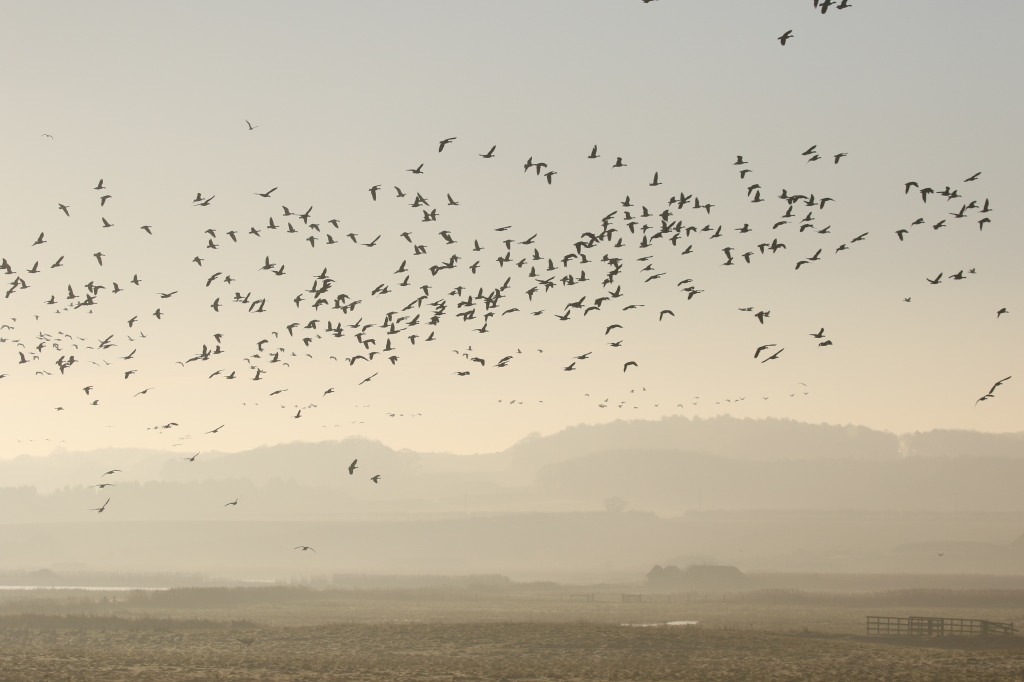
Looking up the back of the beach towards Blakeney Harbour, a Barn Owl was flushed from the grass by a Common Buzzard on Blakeney Chapel. Unfortunately it disappeared round the back and didn’t reappear.
There were not many gulls on the beach this morning. A 1st winter Great Black-backed Gull was feeding on the remains of the dead seal pup by the pill box, and there was no sign of the Iceland Gull commuting up and down this morning. A distant Red-throated Diver was just about the only thing on the sea.
We decided to try round at Weybourne, as the Iceland Gull has wandered this section of the coast too on previous mornings before settling down at Cley. From up on the top of the shingle, we could see several gulls further up on the beach but no sign of the Iceland Gull. It was interesting to see two races of Herring Gull together, a paler argenteus together with a darker-backed northern argentatus.
We were just talking about the Herring Gulls when we turned round to see the Iceland Gull flying along the beach behind us. It flew straight past, giving us a great view – a juvenile, pale biscuit-coloured, peppered with darker markings. The Iceland Gull tried to land with the gulls further up but it was chased off and disappeared away towards Cley.
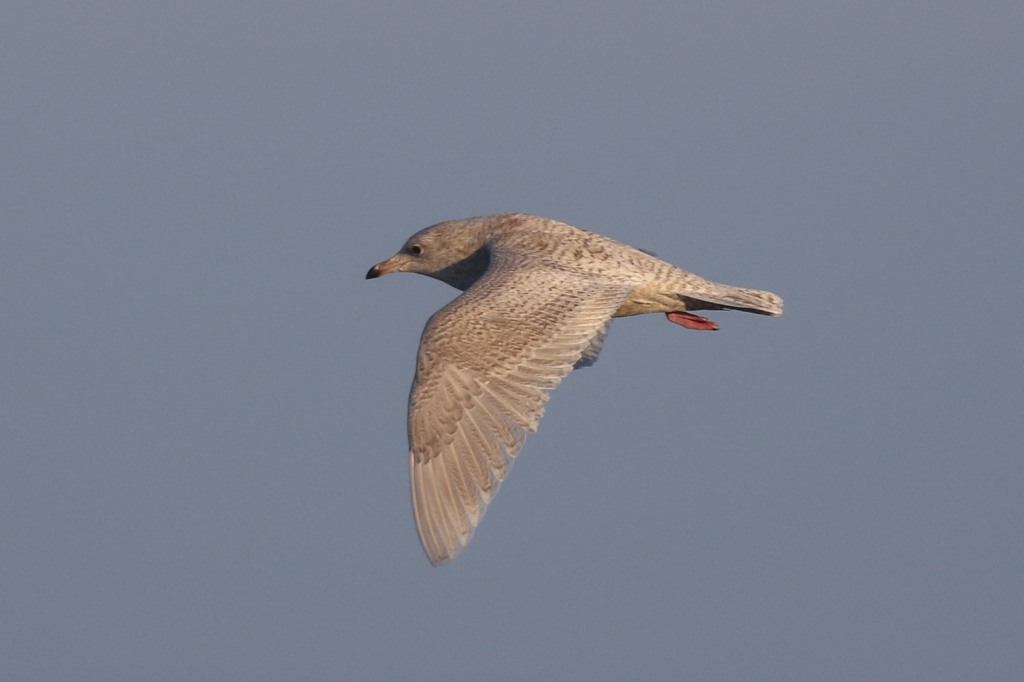
Scanning out across the sea, there were a couple more Red-throated Divers offshore, a little closer in than the earlier one. A single Guillemot and a sleeping Great Crested Grebe were a little further out.
Mission accomplished, we didn’t need to try for the Iceland Gull along the beach at Cley now. We did still call in briefly at the Visitor Centre to see what was around. As we arrived, everything came up off Pat’s Pool – Lapwings, Avocets, Black-tailed Godwits, and a couple of Ruff. Once they had settled down again, we had a quick scan from the picnic area with the scope, and picked up several Dunlin with them too.
We had lots we wanted to try to fit in today, so we continued on west. There had been a Scaup reported in Holkham Park for the last few days, so we parked in the village car park and walked in through the trees. A Great Spotted Woodpecker was on the feeders and a Jay flew over and landed in the long grass by the path. As we approached the Monument, we came across a tit flock in the trees – several Treecreepers and one or two Nuthatches were with them.
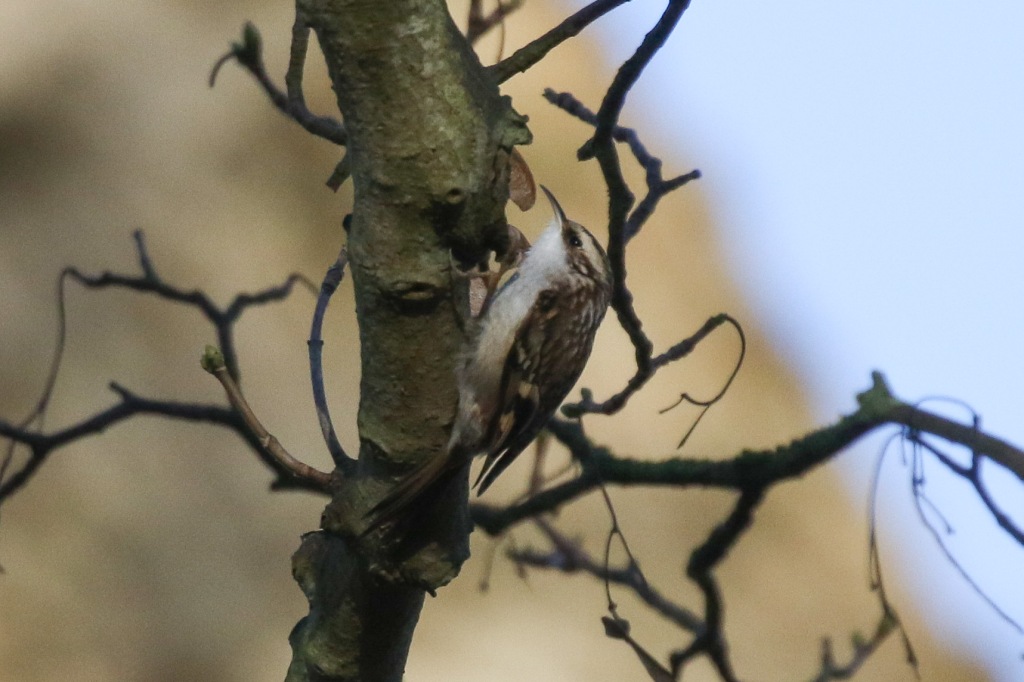
There were lots of Fallow Deer feeding under the trees as we walked through. Three smart bucks were feeding at some buckets behind the Monument and looked stunning in the sun and mist looking towards the Hall.
Continuing down to the Lake, some people ahead of us had set up their scope under the trees. A Great White Egret was perched in the top of a dead tree over on the other side of the Lake.

There were lots of ducks on the Lake and we could see a big raft of Tufted Ducks and Common Pochard further along, so we walked down towards the Hall. Despite a thorough scan through, we couldn’t find any sign of the Scaup today though – it was probably asleep in the vegetation somewhere, out of view.
It was lovely walking in the Park today. We made our way back through the trees to the car park for lunch in the sunshine. After lunch, we drove across to Lady Anne’s Drive. There were lots of Wigeon on the grazing marshes, close to the road, which looked very smart in the sunshine.

We stopped to scan the grass and pools, finding a nice selection of waders out here too now – several Black-tailed Godwits, a few Ruff and Redshank with them.
Further up, we stopped to admire four Grey Partridges feeding right next to the path, unconcerned by all the people walking past.
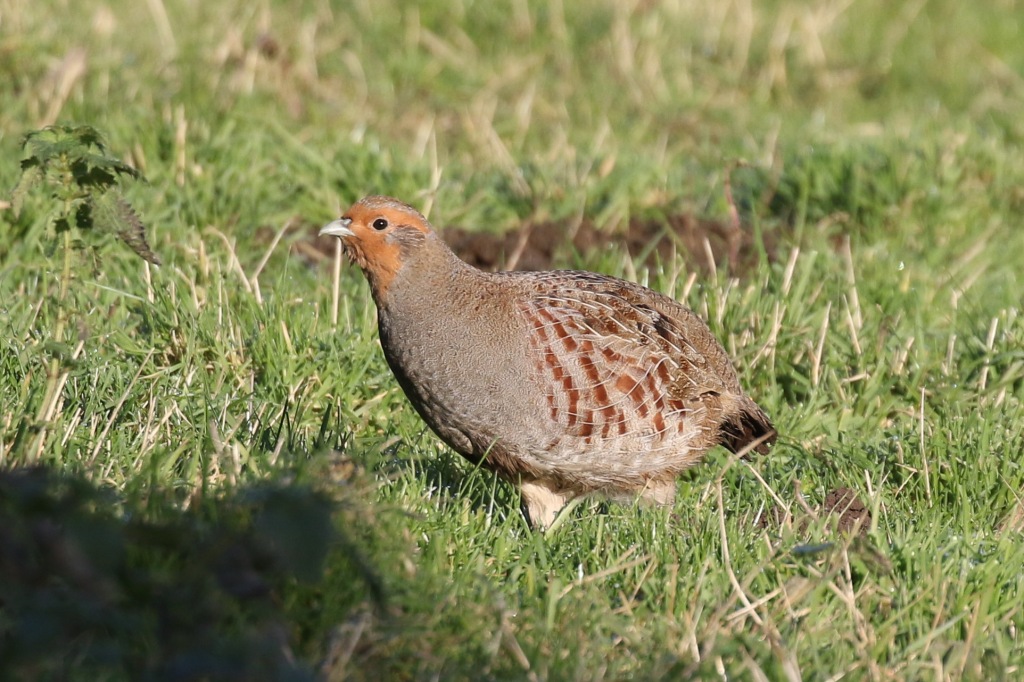
Out through the pines to the dunes, we walked west today. The ground on the north side of the pines was still frozen. A Kestrel flew in from the saltmarsh past us and up over the trees. We could see several small flocks of Sanderling out along the shore.
The beach was stunning, and almost empty this side until we got beyond the dunes where the Little Terns nest in summer. We could see a few birders in the dunes now further up, scanning with scopes. There was no sign of the Shorelarks at first, but then we picked them up still a long way west, out in the middle of the beach among the piles of dead vegetation washed in by the tide.
We walked a little further up, and got slightly closer to the Shorelarks, but that was about as far as we could walk today. It was an OK view through the scopes – we could see their canary yellow faces as they caught the sun.

We had a quick look out to sea. There were several Eider out on the water, and a small raft of Common Scoter. We picked up two distant Red-breasted Mergansers, then a closer male flew past. A Red-throated Diver flew in and dropped down onto the sea.
We cut back through the pines to Joe Jordan Hide, where we took advantage of the opportunity to have a sit down. There were lots of geese out on the grass, mostly Pink-footed Geese. Six White-fronted Geese were feeding around a small pool quite close to hide, and we could see more further back, on the old fort.
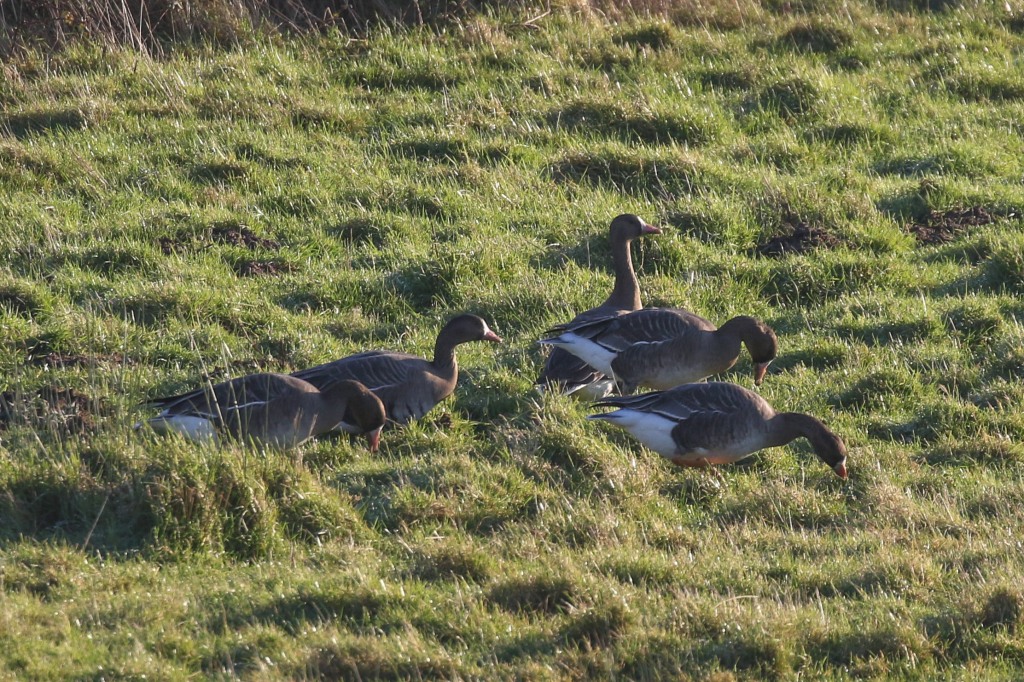
There were lots of Curlew feeding out on the grass too. A Great White Egret was lurking in the rushes on the near edge of the big pool.
We walked back along the track on the inside of the pines. When we got almost to Meals House we stopped to watch a Goldcrest in the holm oaks ahead of us. Then we realised there was a tit flock in the trees the other side, opposite the house, with several more Goldcrests. A Chiffchaff was flitting around in the sunshine too.
Almost back to Lady Anne’s Drive, we heard Bramblings calling. We looked up to see a small flock perched high in the tops of poplars. Another small group flew in, presumably coming in to roost.

As we got to Lady Anne’s Drive, small flocks of Pinkfeet were coming up from the fields towards Wells, flying off south over the Park, calling. The Grey Partridge were still out on the grazing marsh and a Common Snipe was on the edge of the water further back.
A couple of Mistle Thrushes flew up from the grass the other side of the Drive from where we were parked, and landed with a Song Thrush in one of the poplars. The Song Thrush dropped back down, and we walked over to look at the grass, to find several Fieldfares out there too.
There was a lovely sunset this evening, dropping down over the Park and behind the church. We stood and watched from beside the minibus, a nice end to a couple of classic winter birding days here in Norfolk. Then, with the temperature dropping again, we retired to the minibus and headed for home.
















